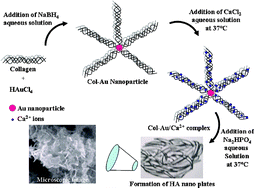Immobilization of collagen on gold nanoparticles: preparation, characterization, and hydroxyapatite growth
Abstract
The growth of hydroxyapatite (HA) on self-assembled collagen

* Corresponding authors
a Department of Bionanosystem Engineering, Chonbuk National University, Jeonju, 561-756, Republic of Korea
b
Department of Textile Engineering, Chonbuk National University, Jeonju, 561-756, Republic of Korea
E-mail:
khy@moak.chonbuk.ac.kr
Fax: +82-63-270-2348
Tel: +82-63-270-2351
The growth of hydroxyapatite (HA) on self-assembled collagen

 Please wait while we load your content...
Something went wrong. Try again?
Please wait while we load your content...
Something went wrong. Try again?
S. Aryal, R. Bahadur K. C, S. R. Bhattarai, P. Prabu and H. Y. Kim, J. Mater. Chem., 2006, 16, 4642 DOI: 10.1039/B608300E
To request permission to reproduce material from this article, please go to the Copyright Clearance Center request page.
If you are an author contributing to an RSC publication, you do not need to request permission provided correct acknowledgement is given.
If you are the author of this article, you do not need to request permission to reproduce figures and diagrams provided correct acknowledgement is given. If you want to reproduce the whole article in a third-party publication (excluding your thesis/dissertation for which permission is not required) please go to the Copyright Clearance Center request page.
Read more about how to correctly acknowledge RSC content.
 Fetching data from CrossRef.
Fetching data from CrossRef.
This may take some time to load.
Loading related content
